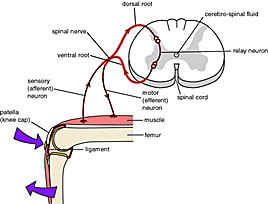Patellar reflex
Editor-In-Chief: C. Michael Gibson, M.S., M.D. [1]

The patellar reflex or knee-jerk is a stretch reflex.
Mechanism
Striking the patellar tendon with a tendon hammer just below the patella stretches the quadriceps tendon. This stimulates stretch sensory receptors (most importantly, muscle spindles) that triggers an afferent impulse in a sensory nerve fiber of the femoral nerve leading to the lumbar region of the spinal cord. There, the sensory neuron synapses directly with a motor neuron that conducts an efferent impulse to the quadriceps femoris muscle, triggering contraction. This contraction, coordinated with the relaxation of the antagonistic flexor hamstring muscle causes the leg to kick. It has been thought that this type of reflex helps maintain the upright posture.
The patellar reflex is a clinical and classic example of the monosynaptic reflex arc. There is no interneuron in the pathway leading to flexion of the quadriceps muscle. Instead the bipolar sensory neuron synapses directly on a motor neuron in the spinal cord.[1] However, there is an inhibitory interneuron used to relax the antagonistic hamstring muscle.
Purpose
The patellar tendon reflex tests the function of the femoral nerve and spinal cord segments L2-L4.
The absence or decrease of this reflex is known as Westphal's sign.
History
That term knee-jerk was coined by Sir Michael Foster in his textbook of physiology in 1877: "Striking the tendon below the patella gives rise to a sudden extension of the leg, known as the knee-jerk."[2]
Popular culture
The term began to be used figuratively from the early 20th century onwards. O.O. McIntyre, in his New York Day-By-Day column in The Coshocton Tribune, October 1921, wrote: "Itinerant preacher stemming Broadway on a soap box. And gets only an occasional knee-jerk." [2]
Notes
- ↑ William F. Ganong, MD, Review of Medical Physiology, McGraw Hill, 2005, ISBN 0-8385-8282-6
- ↑ 2.0 2.1 http://www.phrases.org.uk/meanings/220600.html
References
- Gurfinkel' VS, Lipshits MI, Popov KE (1974). "Is the stretch reflex a basic mechanism in the system of regulation of human vertical posture?". Biofizika (in Russian). 19 (4): 744–8. PMID 4425696.
See also
| File:Wiktionary-logo-en-v2.svg | Look up knee-jerk in Wiktionary, the free dictionary. |
Template:Reflex
de:Patellarsehnenreflex
it:Riflesso patellare
nl:Kniepeesreflex
sv:Patellarreflex